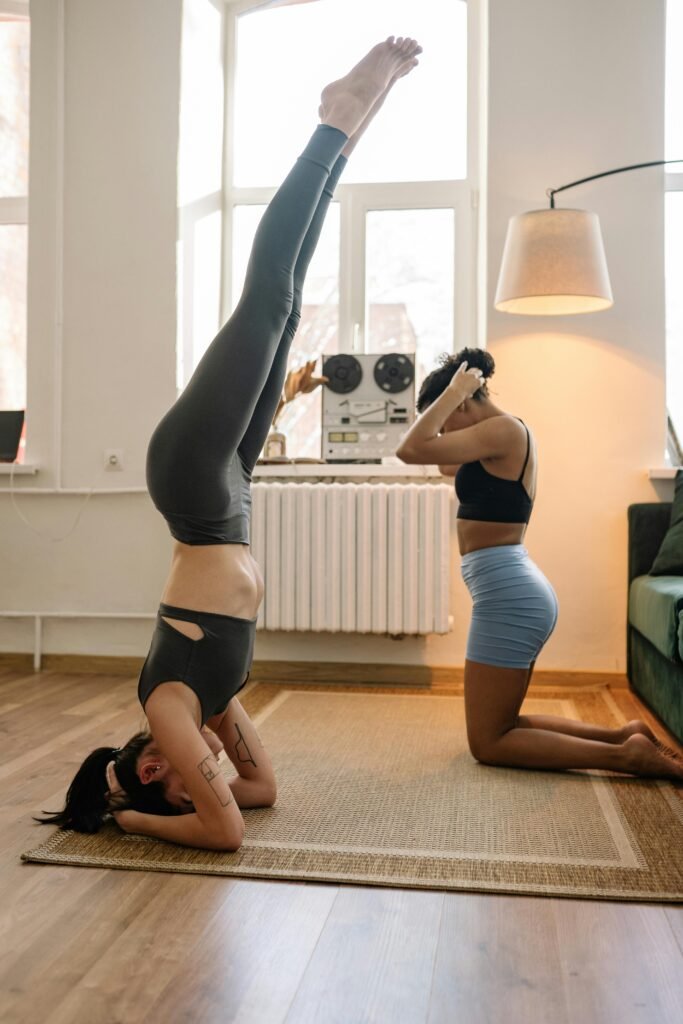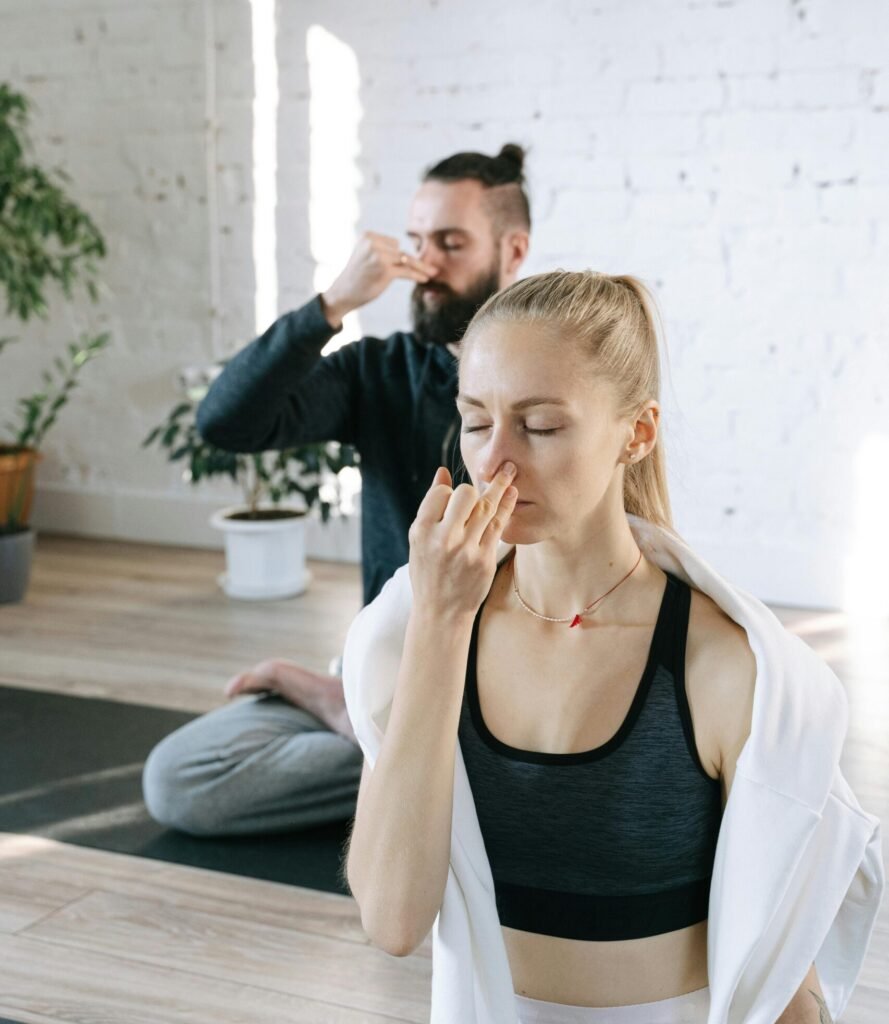You can’t just work out your body with yoga; it’s a practice that balances your mind, body, and spirit. Grounding poses are unique because they help us feel more connected to the Earth, which makes us more stable and balanced. People who want to build a strong base for their body and mind may benefit the most from these exercises.
Table of Contents
Discover the transformative benefits of grounding yoga poses and elevate your practice to new heights. Feel more balanced, centered, and connected to the Earth. Let's Explore
Importance of Grounding in Yoga Practice
A very important part of yoga that helps you feel safe and stable is grounding. The more grounded you are, the better you can deal with stress, stay focused, and enjoy the present moment. The goal of grounding yoga poses is to strengthen this link, which will make you feel more balanced and centred.

When you do grounding yoga poses, you focus on your feet and legs and stand in strong, stable positions. Not only are these poses good for your body, but they are also very good for your mind and emotions. You can get better balance, posture, and a general sense of calm and clarity by adding these poses to your yoga exercise.
The earth element

You might find this article helpful. “CROCODILE YOGA POSE: PRACTICE TIPS, BENEFITS AND VARIATIONS”
In traditional yoga theory, the earth element (also called Prithvi or Bhumi) is one of the five elements. It is linked to stability, strength, and being rooted. The earth itself and the bones, muscles, and tissues in our bodies are the things that reflect it. This element is linked to the muladhara chakra, which is at the base of the spine and is also called the root chakra.
For example, in yoga, grounding poses that make you feel stable and fixed often bring out the earth element. These poses can help us feel more connected to and centred in our bodies. They can also make our muscles and bones stronger and more stable. Integrating grounded yoga poses into our routine can help us feel more connected to the earth element and improve our stability, balance, and focus.
Top 15 Grounding yoga poses
1. Mountain Pose (Tadasana)
Mountain Pose is the foundational pose for all standing poses in yoga. It encourages awareness and creates a strong, steady foundation.
How to Perform:
- Stand with your feet together or hip-width apart.
- Ground through your feet, feeling the connection to the Earth.
- Engage your thighs and lift your kneecaps.
- Lengthen through your spine and lift your chest.
- Relax your shoulders and let your arms hang by your sides or bring them to prayer position at your heart.
2. Tree Pose (Vrksasana)
Tree Pose improves balance and concentration while fostering a deep sense of grounding.
How to Perform:
- Start in Mountain Pose.
- Shift your weight onto your left foot.
- Place the sole of your right foot on your left inner thigh, calf, or ankle (avoid the knee).
- Bring your hands to prayer position at your heart or raise them overhead.
- Hold for several breaths, then switch sides.
3. Warrior I (Virabhadrasana I)
Warrior I is a powerful pose that strengthens the legs and core, promoting stability and focus.
How to Perform:
- Start in Mountain Pose.
- Step your left foot back and turn it out slightly.
- Bend your right knee to a 90-degree angle.
- Raise your arms overhead and keep your shoulders relaxed.
- Square your hips to the front and hold for several breaths.
4. Warrior II (Virabhadrasana II)
Warrior II enhances strength and endurance, increasing flexibility in the hips and shoulders.
How to Perform:
- From Warrior I, open your hips and shoulders to the side.
- Extend your arms parallel to the ground.
- Gaze over your front hand and hold for several breaths.
5. Child’s Pose (Balasana)
Child’s Pose is a resting pose that calms the mind and body, providing gentle stretching.
How to Perform:
- Kneel on the floor with your big toes touching.
- Sit back on your heels and spread your knees wide.
- Lower your torso between your thighs and extend your arms forward.
- Rest your forehead on the mat and breathe deeply.

6. Downward-Facing Dog (Adho Mukha Svanasana)
Downward-Facing Dog stretches the entire body, strengthening the arms and legs while improving circulation.
How to Perform:
- Start on your hands and knees.
- Lift your hips up and back, straightening your legs.
- Spread your fingers and press firmly into the ground.
- Keep your head between your arms and gaze towards your navel.
7. Seated Forward Bend (Paschimottanasana)
Seated Forward Bend calms the mind and stretches the spine, shoulders, and hamstrings.
How to Perform:
- Sit with your legs extended in front of you.
- Inhale and lengthen your spine.
- Exhale and fold forward, reaching for your feet or shins.
- Hold for several breaths, allowing your body to relax.
8. Bridge Pose (Setu Bandhasana)
Bridge Pose strengthens the back, glutes, and legs, opening the chest and shoulders.
How to Perform:
- Lie on your back with your knees bent and feet hip-width apart.
- Press into your feet and lift your hips towards the ceiling.
- Interlace your fingers under your back and straighten your arms.
- Hold for several breaths, then slowly lower your hips.
9. Triangle Pose (Trikonasana)
Triangle Pose stretches the legs and torso, opening the hips and chest while improving balance.
How to Perform:
- Stand with your feet wide apart.
- Turn your right foot out and your left foot slightly in.
- Extend your arms parallel to the ground.
- Reach your right hand forward and down, placing it on your shin or the floor.
- Extend your left arm towards the ceiling and gaze up at your hand.
- Hold for several breaths, then switch sides.
10. Extended Side Angle Pose (Utthita Parsvakonasana)
Extended Side Angle Pose strengthens the legs and stretches the hips and sides of the body.
How to Perform:
- From Warrior II, lower your right hand to the floor or a block outside your right foot.
- Extend your left arm over your head, creating a straight line from your left foot to your left hand.
- Hold for several breaths, then switch sides.

11. Garland Pose (Malasana)
Garland Pose opens the hips and groin, enhancing flexibility and grounding.
How to Perform:
- Stand with your feet slightly wider than hip-width apart.
- Squat down, keeping your heels on the floor.
- Press your elbows against your inner knees and bring your palms together at your chest.
- Lengthen through your spine and hold for several breaths.
12. Half Pigeon Pose (Ardha Kapotasana)
Half Pigeon Pose deeply stretches the hips and glutes, providing a sense of grounding and release.
How to Perform:
- Start in Downward-Facing Dog.
- Bring your right knee forward and place it behind your right wrist.
- Extend your left leg back, keeping your hips square.
- Lower your torso over your right leg and rest your forehead on the mat.
- Hold for several breaths, then switch sides.
13. Cat-Cow Pose (Marjaryasana-Bitilasana)
Cat-Cow Pose is a gentle flow between two poses that warms up the spine and relieves tension.
How to Perform:
- Start on your hands and knees.
- Inhale and arch your back, lifting your head and tailbone (Cow Pose).
- Exhale and round your spine, tucking your chin and tailbone (Cat Pose).
- Continue flowing between these poses with your breath.
14. Reclined Bound Angle Pose (Supta Baddha Konasana)
Reclined Bound Angle Pose relaxes the body and opens the hips and chest, promoting grounding and relaxation.
How to Perform:
- Lie on your back and bring the soles of your feet together, letting your knees fall open.
- Place your hands on your belly or extend them above your head.
- Breathe deeply and hold for several minutes.
15. Corpse Pose (Savasana)
Corpse Pose is a final relaxation pose that integrates the benefits of the practice, grounding the mind and body.
How to Perform:
- Lie flat on your back with your legs extended and arms by your sides.
- Close your eyes and relax your entire body.
- Breathe naturally and hold for 5-10 minutes.
Tips for Practicing Grounding Yoga Poses

1. Focus on Your Breath
Breathing deeply and mindfully enhances the grounding effect of yoga poses.
Tip: Inhale slowly through your nose, allowing your abdomen to expand, and exhale fully. This helps calm your mind and anchors your awareness in the present moment.
2. Move Slowly and Mindfully
Slow, deliberate movements help maintain stability and deepen the grounding effect.
Tip: Take your time transitioning between poses. Pay attention to the sensations in your body and your connection to the ground.
3. Use Props
Props like blocks, straps, and bolsters can help you achieve proper alignment and maintain balance.
Tip: Use a block under your hands in poses like Half Pigeon Pose or Extended Side Angle Pose. Straps can help you reach your feet in poses like Seated Forward Bend.
4. Stay Present
Being present in your practice helps you connect deeply with the Earth and your body.
Tip: Focus on the here and now. If your mind starts to wander, gently bring your attention back to your breath and the sensations in your body.
5. Practice Consistently
Regular practice is key to experiencing the full benefits of grounding yoga poses.
Tip: Incorporate grounding poses into your daily routine, even if it’s just for a few minutes. Consistency will help you build stability and balance over time.
6. Listen to Your Body
Paying attention to your body’s signals can prevent injury and enhance your practice.
Tip: If you feel pain or discomfort, adjust the pose or use props. Always honor your body’s limits and avoid pushing yourself too hard.
7. Combine with Meditation
Meditation can deepen the grounding effect of your yoga practice.
Tip: After your grounding yoga sequence, sit quietly for a few minutes and focus on your breath. This can help you integrate the benefits of your practice and feel more centered.
8. Practice Outdoors
Practicing yoga in nature can enhance your connection to the Earth.
Tip: If possible, take your practice outside. Feel the ground beneath you, the fresh air, and the natural surroundings to amplify the grounding effect.
9. Warm Up Properly
Proper warm-up prepares your body for grounding poses and reduces the risk of injury.
Tip: Start with gentle movements and stretches to warm up your muscles and joints before moving into more intense grounding poses.
10. Cool Down and Rest
Cooling down and resting after your practice helps your body absorb the benefits of the poses.
Tip: Finish your practice with a cool-down sequence and end with Corpse Pose (Savasana) to allow your body and mind to fully relax and integrate the practice.
Conclusion
Asanas that ground you are a powerful way to improve your physical stability, mental focus, and emotional balance. You can become more connected to the Earth and your body by doing these poses as part of your normal yoga routine. Mountain Pose, Tree Pose, and Warrior Pose are all grounding poses that can help you feel more balanced and centred, no matter how experienced you are. Pay attention to your breath, move slowly, and feel what your body is telling you to get the most out of the practice. Grounding yoga poses can give you a deep sense of calm and security if you do them regularly and pay attention to these tips.
FAQ
Most frequent questions and answers
The best time to practice grounding yoga poses is in the morning to start your day with stability, or in the evening to relax and release the stresses of the day.
Yes, grounding yoga poses can help reduce anxiety by promoting a sense of stability and calm, and by activating the parasympathetic nervous system.
You can practice grounding yoga poses daily or a few times a week, depending on your schedule and needs. Consistency is key to experiencing the benefits.
Absolutely! Grounding yoga poses are great for beginners because they help build a strong foundation and improve balance and stability.








Average Rating